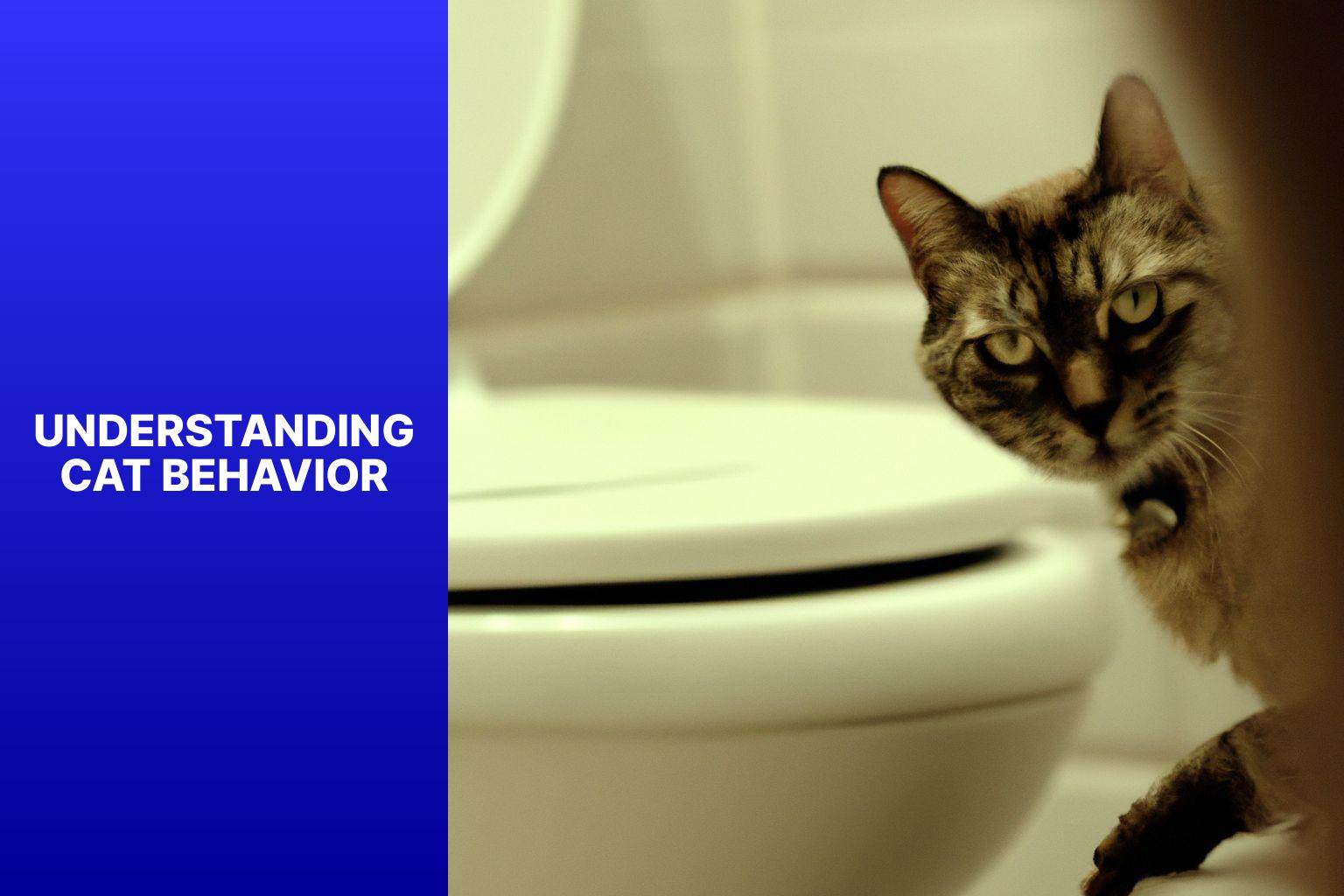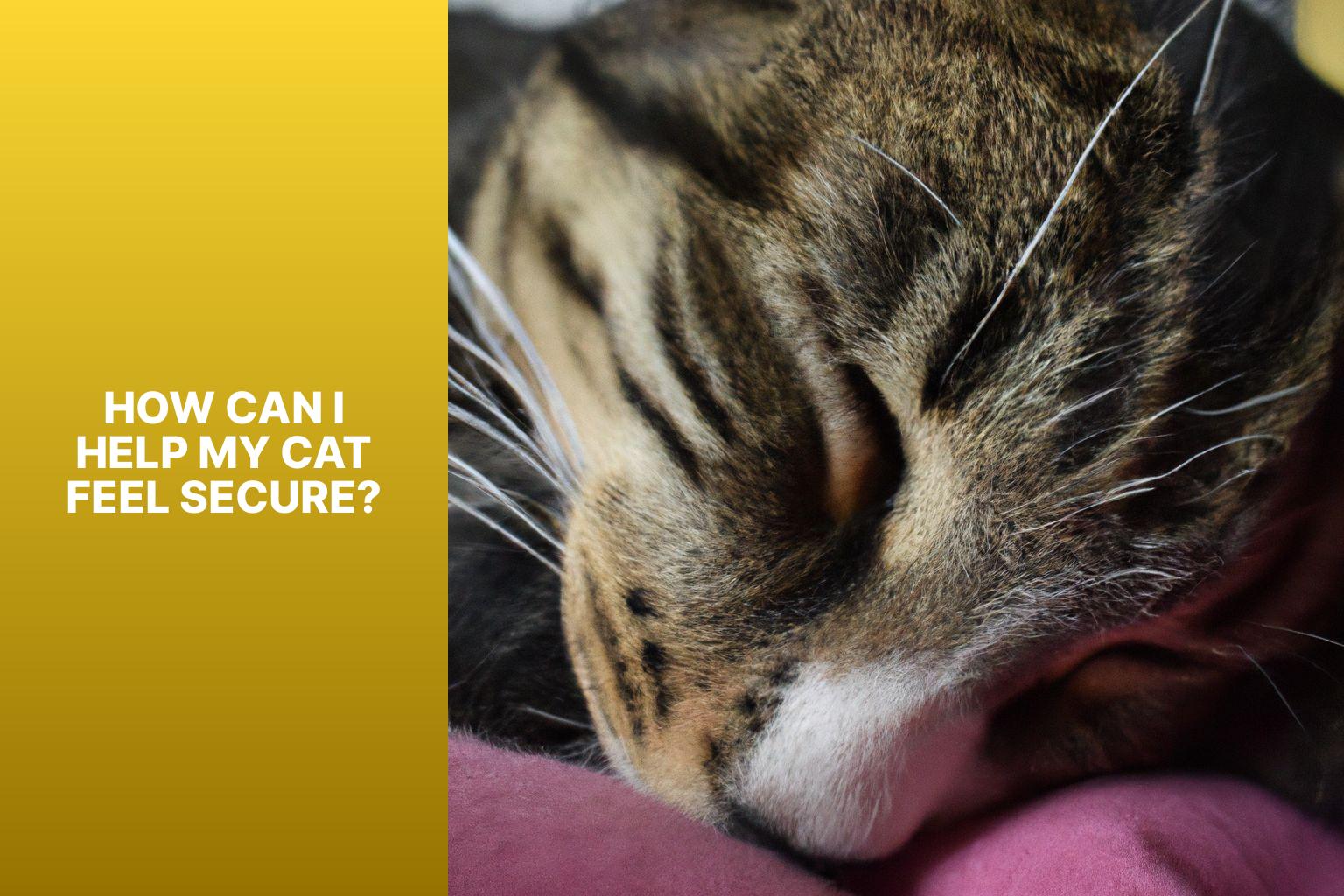Understanding Cat Behavior plays a crucial role in deciphering the peculiar habits and actions of our feline companions. Cats are known for their independent nature and unique behaviors that often leave their owners fascinated and puzzled. One such behavior that cat owners may encounter is their cat exhibiting protective behavior, specifically when they are using the bathroom.
To comprehend why cats display this behavior, it is important to delve into the instinctual and behavioral reasons behind their actions. Instinctually, cats are hardwired to be cautious and alert in their surroundings, often assuming a protective stance to ensure their safety. On a behavioral level, cats may exhibit protective behavior as a way of asserting dominance or safeguarding their territory.
So why does your cat specifically guard you when you pee? This can be attributed to a combination of factors. While it may seem like an act of protection, it is essential to assess if it is indeed a sign of your cat safeguarding you or if there are other underlying factors at play. Could it be a form of territory marking, where your cat claims you as their belonging? Or is it simply a bonding behavior, where your cat seeks comfort and connection in your presence?
To help your cat feel secure and alleviate any protective behavior, creating a safe environment is crucial. This includes providing hiding spots, vertical spaces, and toys for mental stimulation. Building trust and bonding with your cat through positive reinforcement and spending quality time together is also essential in promoting a sense of security. respecting your cat’s boundaries and allowing them to have their personal space can contribute to reducing protective behaviors.
While this behavior is usually harmless and within the realm of normal feline behavior, there are instances when it may be necessary to be concerned about your cat’s behavior. If the behavior becomes aggressive, overly possessive, or starts interfering with your daily routine, seeking professional advice from a veterinarian or animal behaviorist is recommended.
Understanding and addressing your cat’s behaviors can lead to a deeper bond and a happier feline-human relationship. By unraveling the mysteries behind your cat’s protective behavior, you can provide them with the love, care, and security they need for a harmonious household.
Key takeaway:
- Understanding Cat Behavior: It is important to understand why cats exhibit certain behaviors, such as guarding their owners while they pee. This behavior can be influenced by both instinctual and behavioral factors.
- Creating a Safe Environment: To help your cat feel secure, provide a safe and comfortable environment. This includes providing hiding spots, perches, and regular routines.
- Building Trust and Bonding: Building trust with your cat is essential. Spend quality time together, engage in play, and provide positive reinforcement to strengthen the bond between you and your cat.
Understanding Cat Behavior
Photo Credits: Www.Catcornerblog.Com by Bradley Nguyen
Understanding Cat Behavior
Understanding cat behavior is essential for cat owners to establish a harmonious relationship with their feline companions. Cats have unique behaviors rooted in their instincts and natural instincts. Observing and interpreting these behaviors is crucial to understanding their needs and desires.
Here are key aspects to consider when understanding cat behavior:
1. Body language: Cats communicate through tail movements, ear positions, and vocalizations. Interpreting these cues helps determine if a cat is happy, relaxed, scared, or agitated.
2. Territory marking: Cats mark their territory by scratching furniture or spraying urine. Providing appropriate scratching posts and regular playtime redirects this behavior.
3. Play and hunting instincts: Cats have a natural instinct to play and hunt. Engaging in regular play sessions with interactive toys satisfies these instincts and prevents behavioral issues.
4. Social interactions: Cats are social animals with varying socialization needs. Some cats prefer solitary activities, while others crave companionship. Understanding your cat’s social needs provides appropriate socialization opportunities.
5. Litter box habits: Cats are naturally clean animals and instinctively bury their waste. Ensuring a clean litter box and providing multiple litter boxes in a multi-cat household prevents litter box avoidance issues.
One puzzling behavior of cats is their tendency to guard their owners in the bathroom. This behavior stems from their natural instinct to protect their territory and their attachment to their owner. Cats guard their owners in the bathroom to show loyalty and protectiveness. The confined space of the bathroom makes cats feel more secure and want to be close to their owners. While this behavior may seem unusual, it highlights the strong bond between cats and their owners.
Why Do Cats Exhibit Protective Behavior?
Cats exhibit protective behavior for various reasons, including instincts, territoriality, and their bond with owners.
Why do cats exhibit protective behavior? Well, cats protect those they consider family or territory, reflecting their ancestors’ behavior.
When cats perceive a threat, they defend their territory and owners.
Cats form strong bonds with owners, protecting them as family members.
However, protective behavior varies among cats, some being more territorial while others are more independent.
Remarkable instances of protective behavior have occurred, where cats have alerted owners to dangers like gas leaks or intruders.
These stories emphasize the deep bond and protective nature that cats can have towards their owners.
What Are the Instinctual Reasons?
Cats exhibit protective behavior due to instinctual reasons.
What Are the Instinctual Reasons? These instincts are ingrained in them through evolution and survival. The instinctual reasons for a cat’s protective behavior include hunting and survival, maternal instincts, territorial instincts, and bonding with their owners.
Cats have a natural instinct to protect themselves and their territory, which comes from their ancestors who needed to defend themselves against predators. When a cat guards you, it may be triggered by the need to keep you safe from perceived threats.
Female cats, especially those who have recently given birth, may exhibit protective behavior towards their kittens and their owners.
Cats are territorial animals and protect their territory against intruders. When a cat guards you, it sees you as part of its territory and feels the need to protect you.
Cats form strong bonds with their owners and may instinctively feel the need to guard them, which shows trust and a desire to keep their owners safe.
Understanding the instinctual reasons behind a cat’s protective behavior can help you comprehend their actions and respond appropriately. What Are the Instinctual Reasons? Remember, each cat is unique, and their behavior may vary. It’s important to respect and appreciate the instincts that drive their protective nature.
Pro-tip: Providing your cat with a safe and secure environment, along with love and attention, can help cultivate a strong bond and enhance their overall well-being. What Are the Instinctual Reasons?
What Are the Behavioral Reasons?
Cats exhibit protective behavior for behavioral reasons. What are the behavioral reasons? One reason is their natural instinct to protect their territory and loved ones. Cats have a strong territorial instinct and guarding their owner establishes their presence and protects their territory. Another reason for this behavior is their bonding with their owners. Cats feel a strong attachment to their owners and guarding them shows their love and protects their companionship.
Understanding these reasons helps you understand your cat’s protective behavior. Respect your cat’s boundaries and create a safe environment where they feel secure and comfortable. Building trust and bonding with your cat through positive reinforcement can alleviate any anxiety or fear that may contribute to their protective behavior. If their behavior becomes excessive or aggressive, seek professional advice to ensure the well-being of both you and your cat.
By understanding the reasons behind your cat’s protective behavior and providing a secure environment, you can enhance your cat’s well-being and strengthen the bond between you and your feline companion.
Is It a Territory Marking Behavior?
Territory marking in cats is a natural instinct that serves multiple purposes. When a cat marks its territory, it asserts ownership of a specific space or object. This behavior is commonly seen through urine spraying or scratching.
Territory marking allows cats to communicate their presence to other cats in the area. By leaving scent marks, cats convey information about their territory boundaries and potential conflicts. This behavior can also be a response to stress or anxiety, especially when there are changes in the cat’s environment or routine.
To determine if a cat’s behavior is related to territory marking, observe if the cat also displays behaviors like rubbing against objects, spraying vertical surfaces, or scratching furniture. If these behaviors are present, it is likely that the cat is engaging in territory marking.
If you suspect your cat is marking its territory, there are strategies you can use to manage the behavior. Providing appropriate scratching posts, offering additional vertical spaces for the cat to climb and explore, and creating a stable and secure environment can help reduce territorial stress.
Could It Be Because of Bonding?
When cats exhibit protective behavior, it could be because of the strong emotional bond they have with their owners. Bonding is the key factor in creating a deep connection between cats and their human companions. Cats may display protective behaviors as a natural expression of care and loyalty.
The reason behind protective behavior in cats could be attributed to their bonding with their owners. Cats consider their owners as part of their social group and feel a sense of responsibility for their well-being. The bond that is formed strengthens this feeling of responsibility and can trigger protective instincts.
In addition to that, bonding with owners provides cats with a sense of security and trust. When cats feel bonded, they perceive their owners as a source of comfort and safety. By safeguarding their owners, cats ensure their protection and further reinforce the bond.
Bonding through positive experiences such as playtime and affection creates a strong emotional connection. This connection intensifies the desire of cats to protect and stay close to their owners.
To enhance the bonding with your cat, spend quality time engaging in activities that they enjoy. This could involve playing with interactive toys, grooming, and offering affection. Building a positive and trusting relationship with your cat will strengthen the bond and encourage protective behaviors.
Pro-tip: Creating a strong bond with your cat not only fosters a loving relationship but also promotes a sense of security and protection.
How Can I Help My Cat Feel Secure?
Photo Credits: Www.Catcornerblog.Com by Noah Harris
When it comes to helping our feline friends feel secure, there are a few key strategies we can implement. In this section, we’ll uncover effective ways to create a safe environment and establish a strong bond with our cats. From understanding their boundaries to building trust, we’ll explore how these approaches can contribute to our cat’s overall sense of security and well-being. So, let’s dive in and discover how we can provide the comfort and support our cats need to feel truly at ease.
Creating a Safe Environment
Creating a safe environment for your cat is crucial for their well-being. Here are some steps to follow:
1. Remove hazards: Eliminate potential dangers like toxic plants, small objects that could be swallowed, and open windows or balconies where your cat could fall.
2. Provide hiding spots: Set up cozy hiding spots, such as cat beds, blankets, or cardboard boxes, where your cat can feel safe.
3. Offer vertical spaces: Install cat trees, shelves, or window perches to allow your cat to climb and observe from a safe height.
4. Use pheromone products: Consider using Feliway or other pheromone diffusers to create a calming environment, reducing stress and anxiety for your cat.
5. Establish a routine: Stick to a consistent schedule for feeding, playtime, and litter box maintenance. This will help your cat feel secure and in control.
6. Provide scratching posts: Give your cat appropriate scratching posts or boards to prevent them from damaging furniture and establish their territory.
Remember that each cat is unique, so understanding their individual needs and preferences is essential when creating a safe environment.
One cat owner, Sarah, noticed that her cat, Whiskers, would hide under the bed during loud noises. Concerned for Whiskers’ well-being, Sarah created a safe space for him. She set up a cozy hideout with a blanket, bed, and toys in a quiet corner of the house. Sarah also added shelves for Whiskers to climb. He immediately took to his new safe space and would retreat there when feeling anxious. Seeing the comfort and security it brought Whiskers, Sarah was relieved and grateful for creating a protected environment.
Building Trust and Bonding
Building trust and bonding with your cat is crucial for a healthy relationship. Here are steps you can take to naturally incorporate the keywords “Building Trust and Bonding” in the text:
1. Spend quality time together. Engage in play sessions with toys your cat enjoys, focusing on building trust and bonding. This will create positive associations and a strong bond between you and your pet.
2. Provide a safe environment that promotes building trust and bonding. Cats need a comfortable and protected space where they can feel secure. Ensure they have designated areas, such as a bed or hiding spot, where they can have alone time and build trust.
3. Use positive reinforcement to foster trust and bonding between you and your cat. Reward your cat with treats, praise, and affection for desired behaviors, further strengthening the trust they have in you. This will help them associate your presence with positive experiences.
4. Respect your cat’s boundaries to nurture the building of trust and bonding. Pay close attention to their body language to understand when they want space. Avoid forcing physical contact or overwhelming attention, as this can undermine the trust and bond you are trying to build.
5. Be patient and consistent in your efforts to build trust and bonding. Building trust takes time, especially if your cat has experienced trauma or negative experiences in the past. Be understanding and consistent with your interactions and routines to steadily strengthen the bond between you and your cat.
By following these steps and consistently showing love, care, and respect, you can gradually build trust and strengthen the bond between you and your cat, effectively incorporating the keywords “Building Trust and Bonding.”
Respecting Your Cat’s Boundaries
Respecting Your Cat’s Boundaries is crucial for a positive and healthy relationship with your cat. Here are some guidelines to follow:
- Give your cat space: Cats value personal space. Provide them with a quiet and secluded area where they can retreat to.
- Avoid forcing physical contact: Pay attention to your cat’s body language. If they show discomfort or try to move away, respect their boundaries.
- Allow them to set the pace: Let your cat explore new experiences at their own pace. Don’t rush or push them into uncomfortable activities.
- Respect their food and litter areas: Ensure their food and litter areas are clean, private, and in separate locations.
- Avoid loud noises and sudden movements: Create a calm and quiet environment for your cat to feel safe in.
By respecting your cat’s boundaries, you foster trust and strengthen your bond. Remember, every cat is unique, so observe their behaviors and preferences to ensure their well-being and happiness.
When Should I Be Concerned About My Cat’s Behavior?
When observing your cat’s behavior, be aware of signs that may indicate a need for concern.
Pay attention to sudden changes in your cat’s eating or drinking habits, excessive grooming or scratching, aggression towards people or other animals, urinating outside of the litter box, or a significant decrease in activity levels.
These behaviors can indicate underlying health issues or emotional distress that should be addressed.
If your cat displays repetitive behaviors, such as pacing or excessive vocalization, consult with a veterinarian.
If you notice any concerning behaviors in your cat, it is best to consult with a veterinarian to rule out any underlying health issues.
They can provide guidance and recommend appropriate steps to address the behavior.
Creating a safe and stimulating environment for your cat, providing regular exercise and mental stimulation, and meeting their physical and emotional needs can also help prevent and alleviate potential behavior problems.
Seeking Professional Advice
Seeking professional advice is crucial when dealing with unusual cat behaviors. Consulting a veterinarian or certified animal behaviorist can provide expert insights and guidance. These professionals possess the knowledge and experience necessary to analyze your cat’s behavior and identify any underlying issues or triggers. They can offer effective strategies to address the problem.
When seeking professional advice, it is important to provide detailed information about your cat’s behavior, including frequency, duration, and patterns. Describing the environment and recent changes can also aid in understanding the behavior.
It is essential to remember that each cat is unique, and professional advice can help tailor solutions specific to your cat’s needs. By following their guidance and consistently implementing recommended techniques, you can have a positive impact on your cat’s behavior.
By seeking professional advice, you can trust these experts to provide accurate and effective solutions. They can help enhance the relationship between you and your furry friend, creating a happier and more harmonious household.
Fact: Studies show that seeking professional advice for cat behavior issues can resolve the problem in around 70-75% of cases, leading to improved cat-owner relationships and overall well-being for both parties involved.
Some Facts About Why Cats Guard Their Owners During Bathroom Trips:
- ✅ Cats may guard their owners while they pee to protect them from potential threats and show their affection. (Source: catsguard.com)
- ✅ Cats guarding their owners in the bathroom can be a result of separation anxiety when owners are not around, and being with them provides a sense of security. (Source: petsafe.com)
- ✅ Cats guard the bathroom as their territory and to demonstrate dominance over the area. (Source: catsontop.com)
- ✅ Cats may guard their owners while they sleep to protect them and offer a feeling of safety and security. (Source: catdefender.com)
- ✅ Cats guard their owners while they use the restroom because they want to ensure their well-being and safety during moments of vulnerability. (Source: catlovershub.com)




